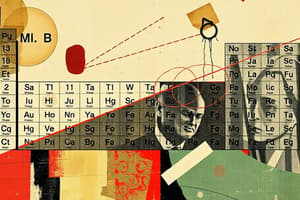Podcast
Questions and Answers
In the modern periodic table, elements are arranged according to?
In the modern periodic table, elements are arranged according to?
increasing atomic number
Which of the following elements has the highest electronegativity?
Which of the following elements has the highest electronegativity?
- Fluorine (correct)
- Carbon
- Hydrogen
- Oxygen
The first periodic table was published by?
The first periodic table was published by?
Mendeleev
What name is sometimes used to refer to the entire set of d-block elements?
What name is sometimes used to refer to the entire set of d-block elements?
Which group of elements is designated as the halogens?
Which group of elements is designated as the halogens?
The elements in group 1 are known as the?
The elements in group 1 are known as the?
__________ may be defined as one-half the distance between the nuclei of identical atoms that are bonded together.
__________ may be defined as one-half the distance between the nuclei of identical atoms that are bonded together.
__________ electrons are available to be lost, gained, or shared in the formation of chemical compounds.
__________ electrons are available to be lost, gained, or shared in the formation of chemical compounds.
The electronegativities of f-block elements?
The electronegativities of f-block elements?
The energy change that occurs when an electron is acquired by a neutral atom is called the atom's?
The energy change that occurs when an electron is acquired by a neutral atom is called the atom's?
A positively charged ion is called a?
A positively charged ion is called a?
Second ionization energies are _______ than first ionization energies.
Second ionization energies are _______ than first ionization energies.
Which of the following elements has the largest atomic radius?
Which of the following elements has the largest atomic radius?
D-block elements are ____
D-block elements are ____
What block does the following element belong to: oxygen?
What block does the following element belong to: oxygen?
What block does the following element belong to: tungsten?
What block does the following element belong to: tungsten?
What block does the following element belong to: plutonium?
What block does the following element belong to: plutonium?
What block does the following element belong to: magnesium?
What block does the following element belong to: magnesium?
What block does the following element belong to: francium?
What block does the following element belong to: francium?
Define periodic law.
Define periodic law.
Describe Mosley's contributions to the modern periodic table.
Describe Mosley's contributions to the modern periodic table.
State the general period and group trends among main-group elements for atomic radii.
State the general period and group trends among main-group elements for atomic radii.
Explain why the atomic radii trend occurs.
Explain why the atomic radii trend occurs.
State the general period and group trends among main-group elements for first ionization energy.
State the general period and group trends among main-group elements for first ionization energy.
Study Notes
Periodic Table Arrangement
- Elements in the modern periodic table are arranged by increasing atomic number.
- Mendeleev first published a periodic table, organizing elements by atomic mass.
Electronegativity and Ionization
- Fluorine has the highest electronegativity among oxygen, hydrogen, fluorine, and carbon.
- First ionization energy increases across the periodic table, while it decreases down the groups.
- Second ionization energies are always higher than first ionization energies.
Element Groups and Blocks
- Halogens are located in group 17 of the periodic table.
- Alkali metals are found in group 1.
- D-block elements are collectively known as transition elements and are all metals.
- Oxygen belongs to the p block, tungsten is in the d block, plutonium is in the f block, and magnesium is categorized in the s block.
Atomic and Electron Properties
- Atomic radius is half the distance between the nuclei of identical bonded atoms.
- Valence electrons are those available for loss, gain, or sharing in chemical bonding.
- The electronegativities of f-block elements tend to be similar.
- Electron affinity refers to the energy change when a neutral atom acquires an electron.
Cations and Atomic Radius
- A cation is defined as a positively charged ion.
- Francium has the largest atomic radius among hydrogen, francium, chlorine, and bismuth.
Trends in Elements
- Atomic radii decrease across a period and increase down a group due to the increasing nuclear charge and electron cloud expansion.
- Periodic law states that the physical and chemical properties of elements are a periodic function of their atomic number.
Contributions of Mosley
- Mosley contributed to the modern periodic table by organizing elements according to their atomic number rather than atomic mass.
These notes encapsulate critical aspects of periodic trends and atomic properties essential for understanding the periodic table and element behavior.
Studying That Suits You
Use AI to generate personalized quizzes and flashcards to suit your learning preferences.
Description
Test your knowledge with these flashcards covering key concepts from Chapter 5 of Chemistry. Topics include the organization of the periodic table, electronegativity, and historical figures in chemistry. Perfect for revision and preparation for exams.




